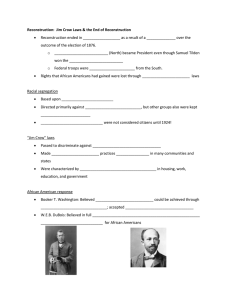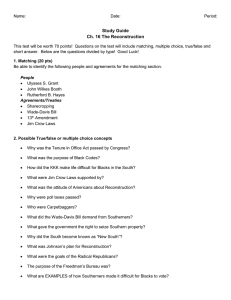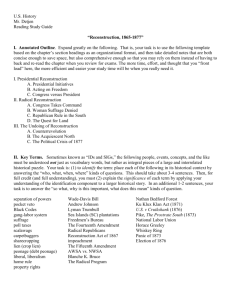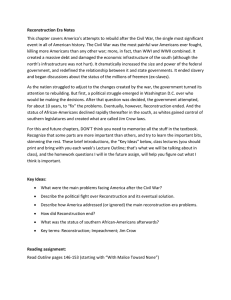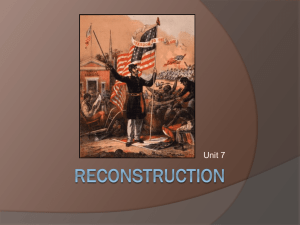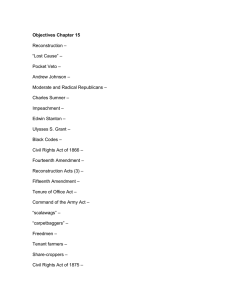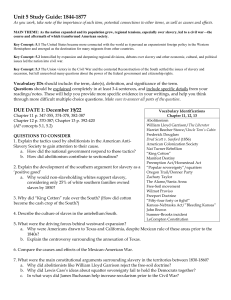Ch 14- The Civil War
advertisement
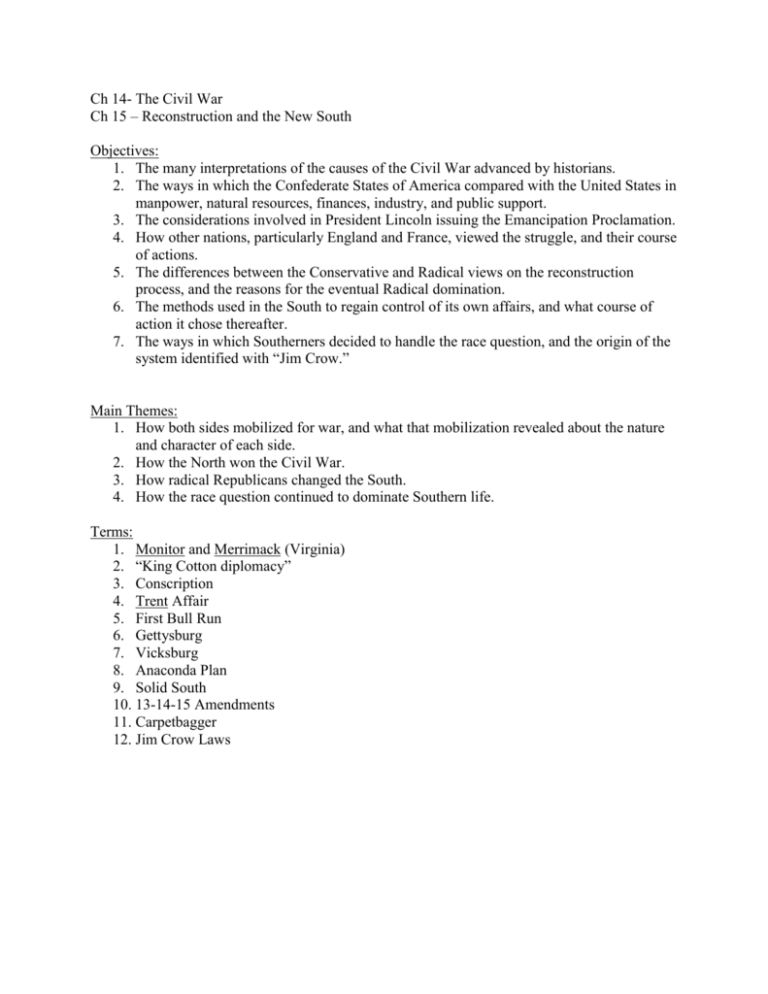
Ch 14- The Civil War Ch 15 – Reconstruction and the New South Objectives: 1. The many interpretations of the causes of the Civil War advanced by historians. 2. The ways in which the Confederate States of America compared with the United States in manpower, natural resources, finances, industry, and public support. 3. The considerations involved in President Lincoln issuing the Emancipation Proclamation. 4. How other nations, particularly England and France, viewed the struggle, and their course of actions. 5. The differences between the Conservative and Radical views on the reconstruction process, and the reasons for the eventual Radical domination. 6. The methods used in the South to regain control of its own affairs, and what course of action it chose thereafter. 7. The ways in which Southerners decided to handle the race question, and the origin of the system identified with “Jim Crow.” Main Themes: 1. How both sides mobilized for war, and what that mobilization revealed about the nature and character of each side. 2. How the North won the Civil War. 3. How radical Republicans changed the South. 4. How the race question continued to dominate Southern life. Terms: 1. Monitor and Merrimack (Virginia) 2. “King Cotton diplomacy” 3. Conscription 4. Trent Affair 5. First Bull Run 6. Gettysburg 7. Vicksburg 8. Anaconda Plan 9. Solid South 10. 13-14-15 Amendments 11. Carpetbagger 12. Jim Crow Laws Summary: Before 1860, references to the nation generally began “these United States are,” but after 1865, it became more frequently “the United States is.” In that change, one might well see the most important outcome of the American Civil War. The question of the nature of the Union, which had been debated since its inception, was settled – the nation was one and indivisible. The cost had been great, in both human and financial terms, but the war had done more than defeat a secessionist rebellion. It had set the nation on a new course. States’ rights, as an alternative to nationalism, had been dealt a fatal blow. Slavery was abolished, free labor was triumphant, and industrial growth and material progress seemed to lie ahead. The war, therefore, was more than a victory for the armies of the Union – the real victor had been the Union itself. Never again would the supremacy of national laws be seriously questioned. The Civil War gave birth to the modern United States. Indeed, it did end an era and begin another. The military aspect of the American Civil War lasted less than five years and ended in April 1865, but it would take another dozen years of Reconstruction to determine what the results of the war would be. The only questions clearly settled by the time Appomattox were that the nation was indivisible and that slavery must end. The nation faced other issues with far-reaching implications. What would be the place of the freedmen in Southern society? How would the rebellious states be brought back into their “proper relationship” with the Union? The victorious North was in a position to dominate the South, but Northern politicians were not united in either resolve or purpose. For over two years after the fighting stopped, there was no coherent Reconstruction policy. Congress and the president struggled with each other, and various factions in Congress had differing views on politics, race, and union. Congress finally won control and dominated the Reconstruction process until Southern resistance and Northern ambivalence led to the end of Reconstruction in 1877. Enormous changes had taken place, but the era still left a legacy of continuing racism and sectionalism that was revealed when Southern whites established the Jim Crow system to evade the spirit of the Fourteenth and Fifteenth Amendments. Meanwhile the South continued its colonial relationship with the North, and Southern plain folk, black and white, found themselves trapped by crop liens in circumstances some felt were almost as bad as slavery.
